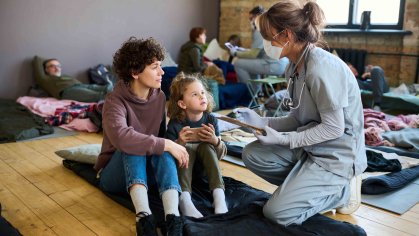Why Bystanders May Hold the Key to Reducing Gun Violence

A Rutgers professor and other researchers create a national baseline of firearm exposure among youth and young adults that could guide development of intervention programs
Findings from a groundbreaking national study co-led by a Rutgers researcher suggests that bystanders – those exposed to gun violence or threats but not directly victimized – may play a critical role in preventing future violence.
Published in Frontiers in Public Health, the study is the first nationally representative baseline of youth and young adult exposure to firearms in the United States, and lays critical groundwork for designing future prevention. Researchers found that curbing gun violence may rely not only on strong laws but on equipping bystanders with the skills and resources to speak up about risky behaviors before a trigger is pulled.
“To solve our country’s gun violence crisis we need solutions that include working with those exposed to violent acts, not only those directly victimized,” said Victoria Banyard, a professor at the Rutgers School of Social Work and a study coauthor.
From a prevention standpoint, we want to understand who those bystanders are, what motivates them to take action, and what kinds of actions are helpful and safe in averting violence before it happens.
Victoria Banyard
Professor, Rutgers School of Social Work
Bystander intervention programs – which help people recognize and report harmful actions – have been proven to prevent crimes such as bullying and assault. Training workers in nightlife settings, such as bar staff and Uber drivers, for instance, has helped reduce sexual violence in urban areas.
But the effectiveness of bystander training on reducing gun violence is unclear, in part because little is known about exposure. To address this gap, the researchers measured the context and frequency of youth and young adults’ experience with someone else’s gun violence, threats and risky behaviors.
Data was collected from 5,311 people aged 10 to 34 who were part of the Growing Up with Guns study, a nationally-representative survey administered by NORC at the University of Chicago and weighted to U.S. The research team included principal investigators Kimberly J. Mitchell, a research professor at the University of New Hampshire’s Crimes Against Children Research Center, and Bruce Taylor, at NORC.
In online surveys completed between September 2023 to January 2024, the researchers asked participants whether they had ever seen or heard a gunshot in public; heard or seen anyone they know talking about hurting someone or themselves with a gun; or known someone of any age who possessed a gun illegally.
Respondents also reported demographic characteristics and details about their home life and neighborhoods.
The results, fielded via NORC’s AmeriSpeak probability-based panel and weighted to U.S. Census benchmarks, paint a stark picture of the ubiquity of guns and gun violence in American society.
Seven in 10 participants reported being exposed to firearm violence, threats or risky behavior at least once in their lifetime. More than four in 10 said they had witnessed a shooting in a public place. One in five knew someone who had killed or tried to kill themselves with a firearm. And about one in 10 had heard or seen someone they know talking or posting on social media about hurting themselves with a firearm.
Most revealing, the researchers said, was nearly half of the participants had knowledge of risky access to or possession of a firearm.
Exposure disparities were detected along demographic lines. Rates were highest among older participants, women, and participants identifying as gender and sexual minorities, Black or African American, American Indian or Alaska Native or of two or more races. Living in lower income households and in urban communities was associated with higher exposure rates.
The researchers said the findings offer important insights into future development of gun violence prevention and intervention efforts.
“A more thorough contextual understanding of firearm violence exposures, including relationships among the people involved, different ways people intervene, and barriers to intervention, are critical next steps that can help guide the development of new bystander interventions targeting firearm violence,” the researchers wrote.
The goal, Banyard said, is not to expect people to stop an active shooter, but rather, to identify warning signs – someone talking about violence, discussing plans or bragging about access to a weapon – before a shooting takes place.
“Oftentimes, even with school violence, there are people who knew, peers who had an inkling that a friend was at risk and that something might happen,” said Banyard. “From a prevention standpoint, we want to understand who those bystanders are, what motivates them to take action, and what kinds of actions are helpful and safe in averting violence before it happens.”
The research was supported by a grant from the Centers for Disease Control and Prevention.


